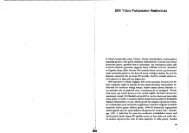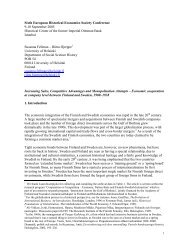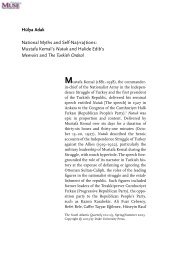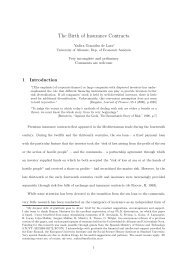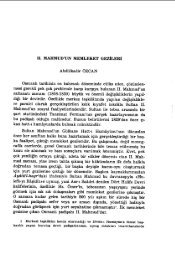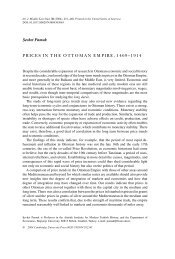West Riding – Western Rhineprovince, 1790-1840: Diverse Paths to ...
West Riding – Western Rhineprovince, 1790-1840: Diverse Paths to ...
West Riding – Western Rhineprovince, 1790-1840: Diverse Paths to ...
You also want an ePaper? Increase the reach of your titles
YUMPU automatically turns print PDFs into web optimized ePapers that Google loves.
<strong>West</strong> <strong>Riding</strong> <strong>–</strong> <strong>West</strong> of the Rhineland, 1780-<strong>1840</strong> 20<br />
Alfred Reckendrees, University of Cologne reckendrees@wiso.uni-koeln.de<br />
paper indicates a different and more conventional interpretation: In contrast <strong>to</strong> the organisation<br />
“firm”, the gild regulations were formal rules (institutions). Ignoring these rules was<br />
quite expensive.<br />
The rules defined precisely the qualities of the woollen cloths of Aix-la-Chapelle; they<br />
were compulsory for all producers, and they limited the employment of capital and labour.<br />
However, within these limits the members of the different gilds could dispose independently.<br />
Thereby they maintained their entrepreneurial function what can be recognised by<br />
the vast freedom of contract. However, the master-artisans did not bear a risk; in this system<br />
of production the cloth-merchant carried the commercial risk in the same way as the<br />
merchant in the putting-out system. The work of the master-artisans, in particular that of<br />
the cloth-makers in relation <strong>to</strong> the cloth-merchants, appears on the one hand as some kind<br />
of “service”; also the fee “against piece wage” points out <strong>to</strong> this perception. On the other<br />
hand, they were master-artisans working with own means of production (workshops and<br />
<strong>to</strong>ols) employing journeymen and apprentices, and they were able <strong>to</strong> conclude a free contract.<br />
Nevertheless, the rules and regulations of the gilds bear a relevant potential of conflict.<br />
Again and again the large cloth-makers and other master-artisans tried <strong>to</strong> enlarge their<br />
control of production; and at the same time the erosion of the gilds endangered the position<br />
of the handicraft gilds where the business of the master-artisans was based on. 75<br />
In the 18 th century the possible entrepreneurial profit was probably directly related <strong>to</strong> product<br />
quality. Therefore, the cloth-merchants were definitely engaged in a high quality production.<br />
They purchased the wool mostly personally and they personally controlled it’s<br />
sorting and selecting. The second most important stage of production in order <strong>to</strong> achieve<br />
high quality products was careful and thorough finishing. Because of these reasons the<br />
more successful cloth-merchants looked for possibilities <strong>to</strong> integrate wool preparation and<br />
finishing in<strong>to</strong> own workshops. These manufactures that were established in the first and<br />
second third of the 18 th century mainly in the gild-free <strong>to</strong>wns of Burtscheid, Eupen, Montjoie,<br />
and Vaals included generally selecting, sorting, washing, and scouring of the wool<br />
and the dressing of the cloth (including shearing and pressing). 76 Spinning and weaving<br />
remained domestic work on putting-out basis. Dyeing and fulling was done by separate<br />
“firms” specialised master-artisans who own their means of production and work for different<br />
cloth merchant-manufacturers. 77 While dyeing required the knowledge of the masterdyer<br />
who never participated a second person in his knowledge, fulling required a fulling<br />
mill that could not be simply erected because it required the respective licence <strong>to</strong> use the<br />
scarce resource of water power.<br />
The main reason of the cloth-merchants attempt <strong>to</strong> integrate dressing and shearing was<br />
controlling the work of the shearmen because this was crucial for the quality of the cloth.<br />
75 See regarding the resulting conflicts: Heizmann, Lage (1923), 14p., 42p.; Seidl, Wollenindustrie<br />
(1923), 46p.; Kermann, Manufakturen (1972), 118p.; Winzen, Auseinandersetzungen (1994); Ebeling,<br />
Handwerkswirtschaft (1997), 327pp.; Pfister, Produktionsregimes (2004), 170p., 174p.; Anonym,<br />
[Clermont] Freymüthige Betrachtungen (1788).<br />
76 Seidl, Wollenindustrie (1923), 51p., 60; Kermann, Manufakturen (1972), 121p.<br />
77 See e.g. the description of cloth production in Burtscheid, Schmidt, Burtscheid (1997), 15-18.



